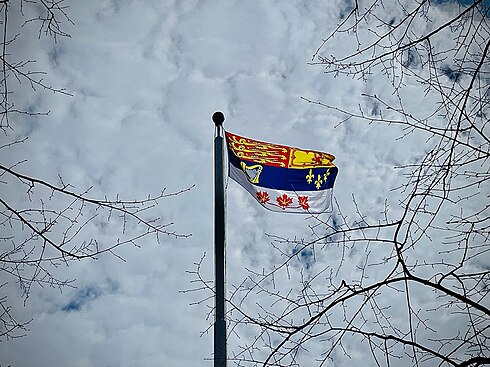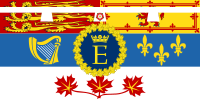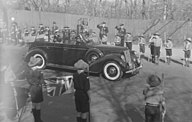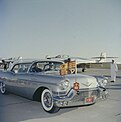Royal Standards Of Canada
The royal standards of Canada are a set of personal flags used by members of the Canadian royal family to denote the presence of the bearer within any vehicle, building, or area within Canada or when representing Canada abroad.
All are based on a banner of the coat of arms of Canada, which are the arms of the Canadian monarch.
The Sovereign's Flag for Canada (also known as the royal standard and the banner of arms) flying at Government House in Halifax, Nova Scotia, following King Charles III's coronation |
The Canadian monarch's standard consists simply of the coat of arms in flag form. The standards belonging to Prince William, Prince of Wales; Princess Anne, Princess Royal; Prince Andrew, Duke of York; and Prince Edward, Duke of Edinburgh, are differentiated by heraldic labels and roundels with personal identifiers within. One flag, with an ermine border, is for use by the remaining members of the royal family.
The first standard was created for Queen Elizabeth II in 1962. The current flag for the Canadian monarch was unveiled on 6 May 2023, the day of King Charles III's coronation. The flags are part of a larger collection of Canadian royal symbols.
Current standards
The sovereign

The sovereign's personal Canadian flag is a banner of arms of the Royal Coat of Arms of Canada, that is the coat of arms in flag form. The flag has a 1:2 proportion and consists of the escutcheon of the coat of arms, namely the quartered arms of the kingdoms of England, Scotland, Ireland, and France above three maple leaves on a silver background. The official blazon is:
Tierced in fess the first and second divisions containing the quarterly coat following, namely, 1st, gules three lions passant guardant in pale Or, 2nd, Or a lion rampant within a double tressure flory-counter-flory gules, 3rd, azure a harp Or stringed argent, 4th, azure, three fleurs-de-lis Or, and the third division argent three maple leaves conjoined on one stem proper.
The standard was created by the Canadian Heraldic Authority in 2023 for Charles III in his capacity as King of Canada and was unveiled on his coronation day, 6 May 2023. It does not include his personal cypher, as the flag of Queen Elizabeth II did, and it is intended that the banner will be used by all future monarchs of Canada. The standard is protected under the Trade-marks Act.
Other members of the royal family
There are five variants of the sovereign's standard, one each for the Prince of Wales (at present, Prince William); Princess Anne, Princess Royal; Prince Andrew, Duke of York; Prince Edward, Duke of Edinburgh; and one used by any member of the royal family who does not have a personal Canadian flag. The flags were all created by the Canadian Heraldic Authority.
The four personal flags follow a standard pattern, consisting of a banner of arms of the Royal Coat of Arms of Canada in 1:2 proportion, differenced by a silver heraldic label and, in the centre, a blue roundel (or hurt) with a border of 24 gold maple leaves. The roundel on the Prince of Wales's standard contains the Prince of Wales's Feathers and his label is plain. The roundels of the other three personal flags contain the bearer's cypher—the initial of their first name surmounted by a coronet of the child of the monarch. On the labels, all taken from the holder's personal coats of arms, Anne's has a red heart on the centre point and red crosses on the outer points, Andrew's has a blue anchor on the centre point, and Edward's has a Tudor rose on the centre point. The flag for use by other members of the royal family consists of the banner of arms with an ermine border.
- The Prince of Wales
- Princess Anne, Princess Royal
- Prince Andrew, Duke of York
- Prince Edward, Duke of Edinburgh
- Other members of the royal family
Use and protocol
Prior to the adoption of the Canadian royal standards, members of the royal family who toured Canada used the royal standard they employed when in the United Kingdom; although, for the 1860 tour undertaken in 1860 by Prince Albert Edward, Prince of Wales (the future King Edward VII), he used the banner of his mother, Queen Victoria. after 1931, each of those standards took on a dual role of representing a member of either the British or the Canadian royal family, depending on the context.
The King's personal Canadian flag is employed only when the King is in Canada or is attending an event abroad as the Canadian head of state; for example, the flag will be unfurled at Juno Beach in France when the King is present there for commemorations of the Normandy Landings. The flag must be broken immediately upon the sovereign's arrival and fly day and night until lowered directly after the King's departure from any building, ship, aircraft (not in the air), or other space or vehicle, As the monarch is the personification of the Canadian state, his banner also takes precedence above all other flags in Canada, including the national flag and those of the other members of the Canadian royal family.
No other person may use the flag; the King's federal representative, the governor general, possesses a unique personal flag, as does each of the monarch's provincial viceroys. Flags are kept at the King's Ottawa residence, Rideau Hall, and supplied to Department of Canadian Heritage royal visit staff by the household staff prior to the King's arrival.
Protocol is sometimes, though rarely, officially broken. On 9 August 1902, the day of the coronation of King Edward VII, the monarch's royal standard (then the same in Canada as in the United Kingdom) was raised on a temporary flag pole at His Majesty's Dockyard in Halifax, Nova Scotia. Similarly, for the coronation of Queen Elizabeth II on 2 June 1953, the sovereign's royal standard was broken atop the Peace Tower on Parliament Hill in Ottawa. Sixty years later, on 6 February 2012, the Queen's personal standard for Canada was unfurled at Rideau Hall and Parliament Hill, as well as at other legislatures across the country to mark the monarch's diamond anniversary of her accession to the throne; permission to do so was granted by the Queen.
When Police Service Horse Burmese was presented to Queen Elizabeth II by the Royal Canadian Mounted Police on 28 April 1969, she requested that Burmese perform in the Royal Windsor Horse Show and have the rider carry the Queen's royal standard on the lance, instead of the usual red and white pennon, thus allowing Elizabeth to easily follow Burmese's performance.
History
Elizabeth II was the first to use a standard for her role as Queen of Canada. Adopted in 1962, it had a 1:2 proportion and consisted of the banner of arms with the Queen's personal device in the centre—a blue roundel with a border of gold roses, containing within it a capital E surmounted by a crown. It was added to the Canadian Heraldic Authority's Public Register of Arms, Flags, and Badges on 15 March 2005. Nathan Tidridge argued the introduction of this standard set red and white as the national colours of Canada. However, there is debate over whether the proclamation of the coat of arms in 1921 determined Canada's national colours.
The next two personal flags were created for Charles, then-Prince of Wales, and William, then-Duke of Cambridge, and were revealed on 29 June 2011. William's flag consisted of the banner of arms with, in the centre, a blue roundel with a border of 12 gold maple leaves alternating with 12 gold scallops and, within this, his cypher—a W surmounted by a coronet of a child of the heir apparent. The label had a red scallop on the centre point. It was first flown from the Canadian Forces airplane that carried him and his wife, Catherine, to Canada in 2011.
Charles's flag, which is now used by William as Prince of Wales, was first flown from the Royal Canadian Air Force airplane that carried him and his wife, Camilla, to Canada for a royal tour marking the Diamond Jubilee of Elizabeth II. The creation of the flags made Canada the second Commonwealth realm, after the United Kingdom, to adopt unique flags for members of the royal family. The ermine variant was registered on 15 January 2015.
The Princess Royal's banner was first used during her October 2013 visits to CFB Borden and CFB Kingston. Prince Edward's flag was first used on 12 September 2014, during a visit to Government House, British Columbia, with his wife Sophie, as part of a royal tour.
Sean Palmer asserted in the 2018 book, The Canadian Kingdom: 150 Years of Constitutional Monarchy, that, by way of creating the uniquely Canadian standards for members of the royal family other than the monarch, Canada took "'ownership', not only of the Queen of Canada, but, of the other members of her family as well", and that doing so was another formal affirmation of the concept of a Canadian royal family "as distinct as the Queen of Canada is from the Queen of the United Kingdom". Jai Patel and Sally Raudon also noted the following year that the purpose of these heraldic banners was to recognize the owners' roles as members of the Canadian royal family.
- Elizabeth II, Queen of Canada, 1962 to 2022
- Prince William, Duke of Cambridge, 2011 to 2022
Coronation standard
During the coronations of some monarchs at Westminster Abbey, the standards of various countries were carried by officials in the procession inside the abbey. These flags were the countries' coats of arms as banners of arms. Such flags for Canada were used thrice: at the coronations of King George V, King George VI, and Queen Elizabeth II in 1911, 1937, and 1953, respectively. A banner quartered with the arms of the first four Canadian provinces was used in 1911, while the banner of the Canadian coat of arms, as devised in 1921, was used in 1937 and 1953. The banner was in a 3:4 ratio and without defacement.
- Coronation standard used in 1911
- Coronation Standard used in 1937 and 1953
See also
References
- Canadian flags of the Royal Family
- Head of State The Flags of Canada, by Alistair B. Fraser
This article uses material from the Wikipedia English article Royal standards of Canada, which is released under the Creative Commons Attribution-ShareAlike 3.0 license ("CC BY-SA 3.0"); additional terms may apply (view authors). Content is available under CC BY-SA 4.0 unless otherwise noted. Images, videos and audio are available under their respective licenses.
®Wikipedia is a registered trademark of the Wiki Foundation, Inc. Wiki English (DUHOCTRUNGQUOC.VN) is an independent company and has no affiliation with Wiki Foundation.




















